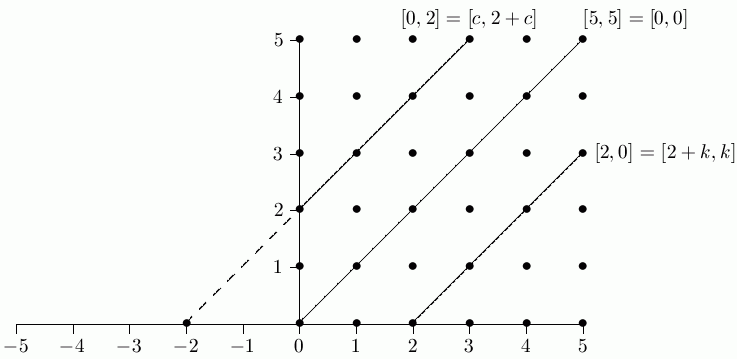This note will follow one of the standard constructions1 of the negative integers and its relation to the Chip Board representation and model for integers. We shall assume that the natural numbers and 0 - the nonnegative integers - N0 = {0, 1, 2, 3,…} are available and the binary operations of addition, +, and multiplication, · are defined so that Properties of Addition
- P1
-
For all a, b, c, in N0,
a + (b + c) = (a + b) + c
- P2
-
There is a number 0 in N0 such that for all a,
a + 0 = 0 + a = a.
- P3
- (Not Yet!) [Additive Inverse]
- P4
-
For all a, b,
a + b = b + a.
- P5
-
For all a, b, c,
a ·(b ·c) = (a ·b) ·c
- P6
-
[Multiplicative Unit] There is a number 1 ≠ 0 such that for all a,
a ·1 = 1 ·a = a.
- P7
- (Not Yet!) [Multiplicative Inverse]
- P8
-
For all a, b,
a ·b = b ·a.
Property of · with +
- P9
-
(Distributive) For all a, b, c,
a ·(b + c) = (a ·b) + (a·c) = a ·b + a·c.
- P3
-
Not Yet! For all a, there is a number −a such that
a + (−a) = (−a) + a = 0.
- P7
-
Not Yet! For all a ≠ 0, there is a number a−1 such that
a ·(a−1) = (a−1) ·a = 1.
|
|
|
Chip Board. Think of the pair (a,b) as a Board with a black chips and b red chips. Adding c black chips and c red chips gives a Board with the same value.
Definition. Consider the collection of all ordered pairs (a,b), a, b ∈ N0. We say that
|
|
Chip Board. For any c ≥ 0, the board with a black chips and b red chips is considered the same (has the same value) as the board with a + c black chips and b + c red chips. Moreover, we can go between two equally valued boards by adjoining or taking away pairs of red and black chips. We can also think of the number a, a ≥ 0, as corresponding to the Board with a black chips and 0 red chips:
|
Chip Board. The Chip Board with 0 black and b red corresponds to the pair (0,b) and also to (c,b +c); thus 0 black and b red corresponds to the equivalence class [0,b]. We must verify that ≅ , is an equivalence relation, i.e., the relation ≅ is
- •
- reflexive : (a,b) ≅ (a,b),
- •
- symmetric : if (a,b) ≅ (a,b), then (a′,b′) ≅ (a,b),
- •
- transitive : if (a,b) ≅ (a′,b′), and (a′,b′) ≅ (a′′,b′′) then (a,b) ≅ (a′′,b′′).
Chip Board. Call an equivalence class the value of any representative board.
- •
- reflexive : Every Board has the same value as its own value.
- •
- symmetric : if Board X has the same value as Board Y, then Board Y has the value of Board X.
- •
- transitive : if Board X has the same value as Board Y, and Board Y has the same value as Board Z, then Board X has the same value as Board Z.
| Addition |
|
|
|
Chip Board. Starting with a black and b red, put down c black and d red. Note that
- •
- A Chip Board corresponding to (a,b) can be obtained by putting down a black chips and then putting down b red chips.
- •
- [a,b] = [a,0] ⊕[0,b].
- •
- Any Chip Board with value 0 has an equal number of black and red chips - c black chips and c red chips. We call such a board the Null Board ↔[0,0] = [c,c].
- •
-
The Null Board (0,0) serves as a Zero for
addition ⊕,
[a,b] ⊕[0,0] = [a,b]
- •
-
[a,b] ⊕[b, a] = [a + b, a +b] = [0,0]. Thus [a,b] has an additive
inverse , usually called −[a,b], such that
[a,b] + (−[a,b]) = [0,0].
- •
- If the Chip Board with a black and b red is joined to the board with the Board with b black and a red constructs the Board with a+b black and a+b red - which is equivalent to the board with no chips (also called the Null Board).
- •
- For a,b ≥ 0, make the correspondences a ↔[a,0], b ↔[b,0]. Then (a + b) ↔ [a+b,0] = [a,0]⊕[b,0].
| Multiplication |
|
|
Chip Board. Much more complicated. The desired distributive property has a major role. On the chip board, multiplying the Board with a black and b red by the number c, c ≥ 0 will construct the Board with a ·c black and b ·c red. I.e.,
|
|
|
|
|
|
|
|
|
|
|
- •
-
The additive inverse of the unit [1,0] is [0,1],
− [1,0] = [0,1].
- •
-
The additive inverse of [a,b] is
[a,b]⊗( additive inverse of the unit ).
− [a, b] = (− [1,0]) ⊗[a,b].
| Subtraction |
|
|
| Notes |
The same equivalence class construction of negative numbers could be carried out starting with the the nonnegative rational numbers or nonnegative real numbers. The role of the chips on the Chip Board might be played by colored lengths of string.
| Geometric Interpretation of Equivalence Classes |

Footnotes:
1I thank John Wood for his explanation of the construction in the style of Grothendieck. † We try to force the rule (−1)[a,b] = −[a,b]File translated from TEX by TTH, version 4.06.
On 24 May 2015, 19:12.